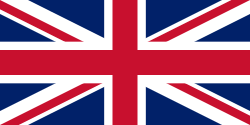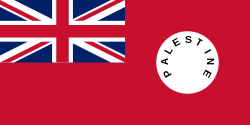




During the Mandate period in Palestine, between 1920 and 1948, when Palestine was governed by Britain under terms which were formalised in the League of Nations Mandate for Palestine of July 24, 1922, [1] the de facto flag was the Union Jack or Union Flag of the United Kingdom, but several localised flags existed for Mandate government departments and government officials. The only Palestine-specific flag not restricted to official government use was the Palestine ensign (red with the Union Flag in the canton, and a white circle on the fly with the mandate's name inside it), which was flown by ships registered in the British Mandate territory from 1927 to 1948. It was based on the British Red Ensign (civil ensign) instead of the Blue Ensign (used as the basis for the flags of nearly all other British-ruled territories in Africa and Asia) since it was intended for use only at sea by non-government ships.




